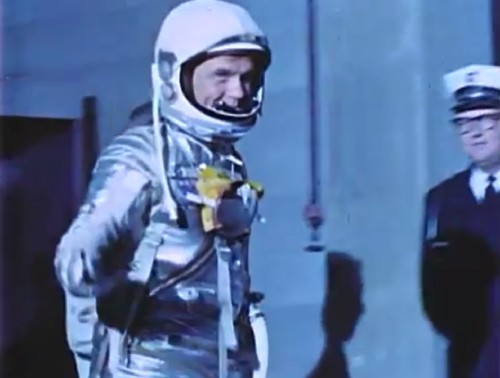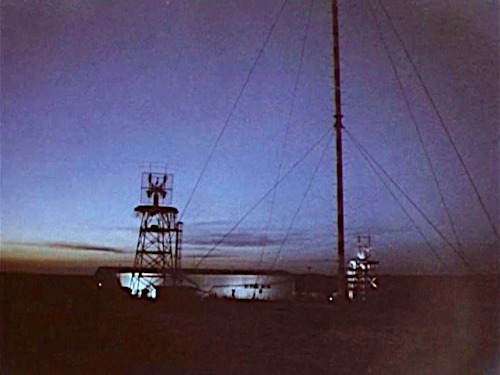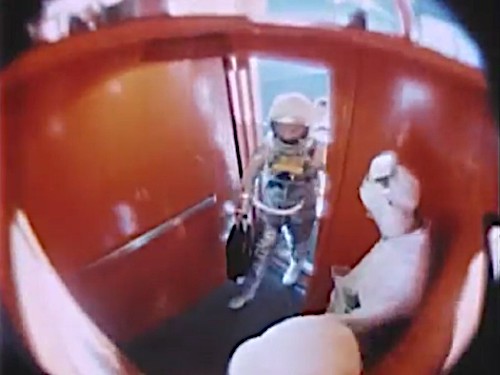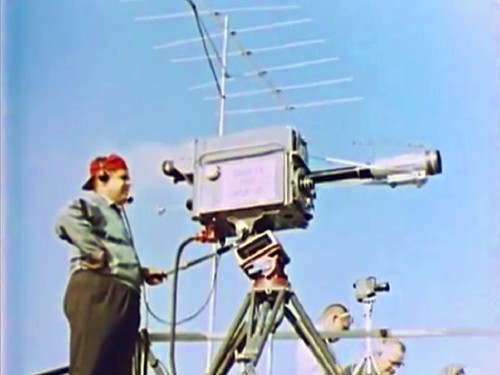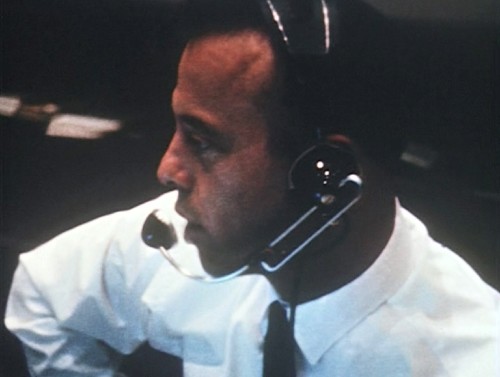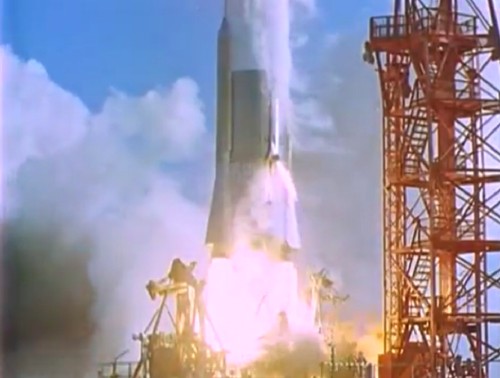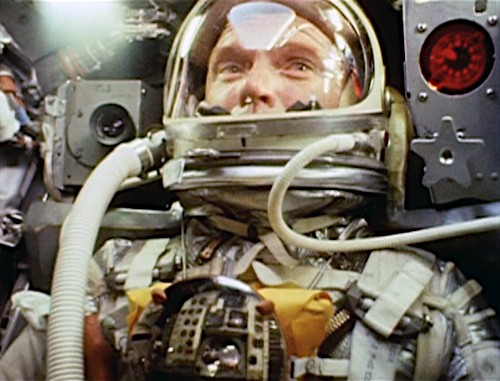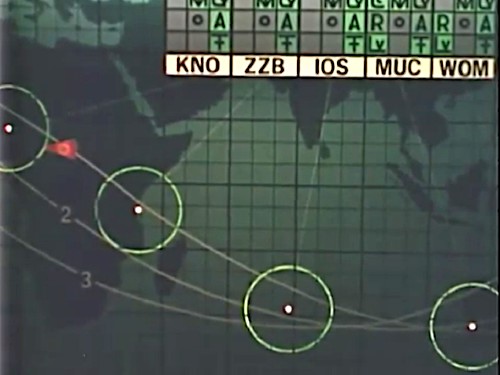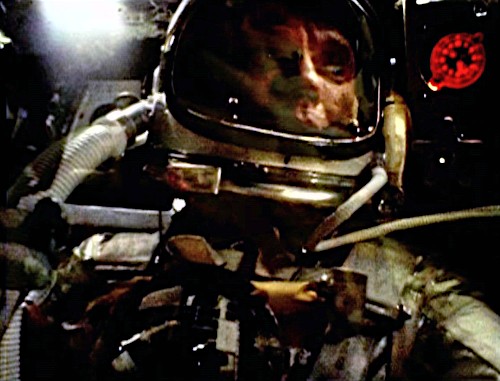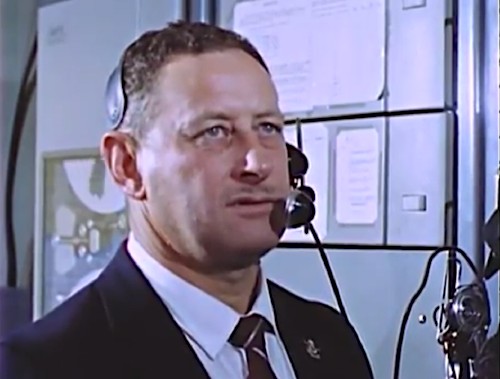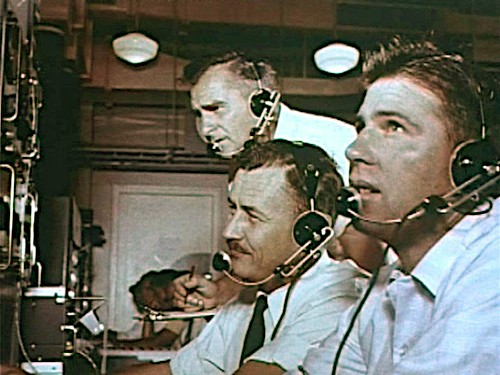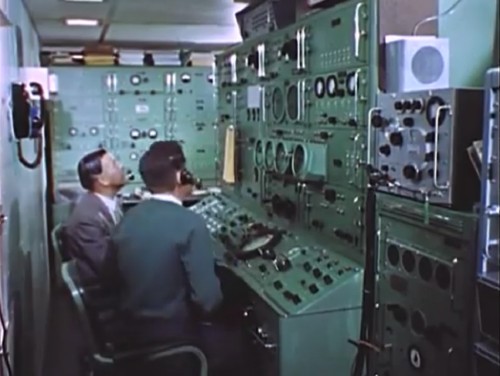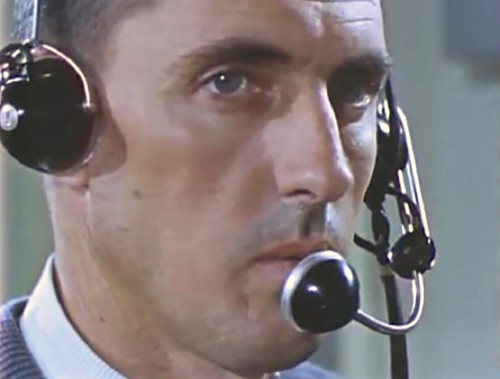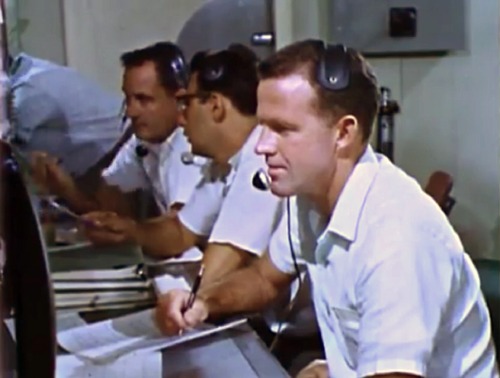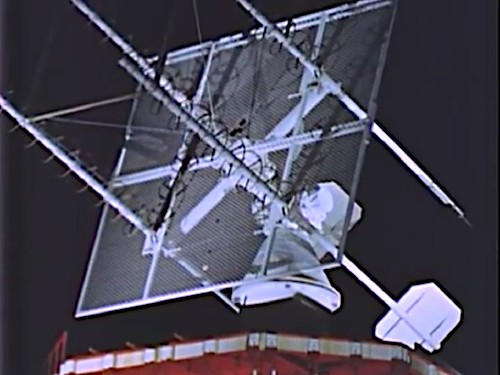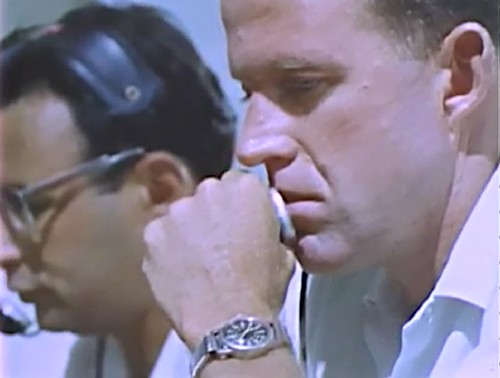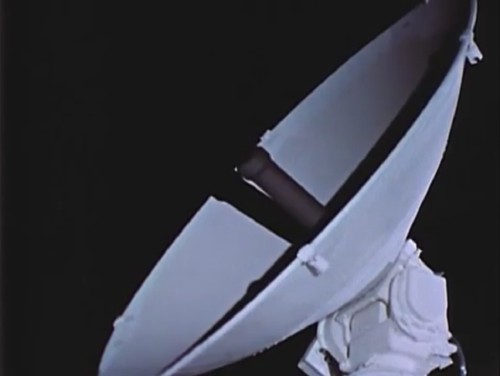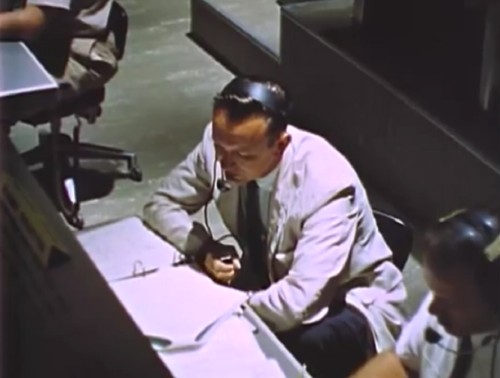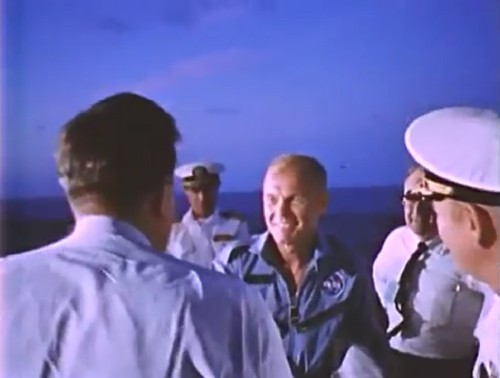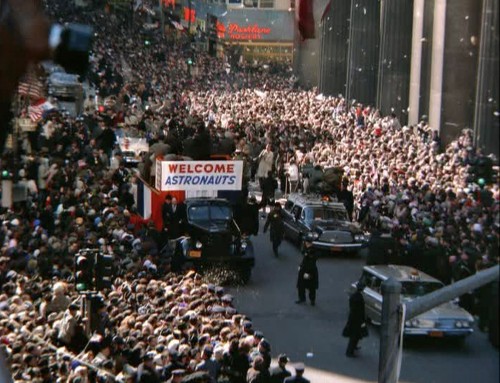1962 – FIRST AMERICAN MANNED ORBITAL FLIGHT.
| MERCURY ATLAS 6 | 20 February 1962 |
| FRIENDSHIP 7 – John Glenn | Flight statistics: 4 Hours 55 minutes 23 seconds. 3 Orbits of 88 minutes 29 seconds each. Distance : 134,441 kilometres. Apogee : 261 kilometres. Perigee : 160.9 kilometres. Max speed : 28,233.5 kilometres per hour. Spacecraft Weight : 1,935 kilograms. |
Originally scheduled for December 20, 1961, it took 82 days of maddening delays to get Friendship 7, the name chosen in contest by his own family, off the ground. Glenn recalls, “We went on the 11th scheduled date and I actually suited up four times and twice was up on top when the mission was scrubbed for weather and equipment problems. One time it was scrubbed when I was suited up and on my way to the pad in the transfer van.”
At last, on the day of launch, after a good night’s sleep Glenn woke up half an hour before Dr. Bill Douglas, the Flight Surgeon, came in to rouse him, and lay there going over the mission procedures. After breakfast with Douglas, Deke Slayton, Walt Williams, and Merritt Preston, chief of the preflight operations division, Glenn went through the medical checkup followed by the suiting up procedures with Joe Schmitt: “Joe is one of the most conscientious and hard working men I know. He is the kind of dedicated citizen and skilful craftsman who makes Project Mercury go.”
Glenn strode past the cluster of well-wishers with a wave and was driven out to Pad 14, accompanied by weatherman Ken Nagler to brief him on the current weather picture.
John Glenn strides towards the transfer van. |
Glenn opened the van window blind and looked out, “I could see the gantry. It was a beautiful sight. It was still dark, but the big arc lights shone white on the Atlas booster. It looked like something out of another world.”
On the other side of the world at Muchea, the station air-conditioning was struggling to cope with sweltering temperatures of 40°C. After so many false starts, there was nothing to indicate that this was going to be the day. As had been their custom, the American flight control team of Astronaut Capcom Gordon Cooper, Assistant Capcom Stanley Faber, and Flight Surgeon Dr. E. Beckman, called in for a while to check on the status of the mission, there being no such luxuries as mobile phones in those days.
It had been a long hot day at Muchea Tracking Station north of Perth. Thankfully, things were cooler by the time Friendship 7 launched at 10:48pmWAST. This view shows the T&C building with Acquisition Aid antennae at either end. The boresight tower is in the foreground. |
The interminable holds continued to interrupt the countdown, but finally at 6:00 am Glenn arrived at the gantry. Coming up to T-120 minutes Glenn rode the elevator to the eleventh deck and met Scott Carpenter, the backup pilot. “Scott was standing off to one side, out of the way, and I walked over to him for a moment. I know something about being a backup pilot, having done the job twice myself. It is hard work, and the personal satisfaction is limited to helping someone else. Scott had pitched in from the beginning as if he were preparing for his own flight, not someone else’s, and I appreciated this very much. Scott was my alter ego.”
In this fisheye lens view, John Glenn enters the elevator to ride to the top of the Atlas booster. |
Glenn climbed into the spacecraft and settled down to an hour of checking procedures before the hatch was closed and sealed. But he had an encore. One of the seventy hatch bolts broke while being tightened down, and it was forty minutes before the hatch was finally secure. Lying there in his suit, moulded into the contoured couch, Glenn could feel the tall pencil-like rocket squirming and vibrating under him as the metal skin flexed, a vertical column of liquid fuel only held in place by a thin metal skin which rippled and shuddered to every movement, even to gusts of wind. Glenn found that he could start the whole structure wobbling a bit just by jerking around in the couch.
Like Shepard and Grissom, he found a relief from the tedious constant checking by peering through the periscope at the limited view. He could see the sun sparkling off the cheerful blue water of the Atlantic one way and swivelling the periscope around could just make out the thousands of people gathered around the beaches and swamps to watch and be part of this moment of history. Some of them had been camped there in temporary communities for nearly a month. An estimated 60 million people watched the launch on live television.
One of the network pool television cameras, sporting a telephoto lens, trained on the pad. |
In Mission Control Alan Shepard was sitting at the Capcom’s console in front of Chris Kraft, talking to Glenn, “I could hear his voice clearly as he read off his meters and gauges to me. He sounded exhilarated and in full command of the situation. When I knew Chris was looking at me I stuck out my left hand and raised it, thumb up. We were on our way.”
Astronaut Alan Shepard in Mercury Control. |
At 35 seconds to go Glenn watched the umbilical cord which provided the power and cooling drop off, the last connection with the ground equipment. All the tracking stations around the world were “Green”, with everything and everyone ready to support Glenn.
Glenn, “Once you got onto the 18 second automatic count, unless somebody pressed the hold button, you were going to go.”
“God speed, John Glenn,” said Scott Carpenter, and the engines fired. Glenn: “The spacecraft shook, not violently but very solidly. When the Atlas was released there was an immediate gentle surge that let you know you were on your way. The roll to the correct azimuth was noticeable after lift-off. I had preset the little window mirror to watch the ground. I glanced up after lift-off and could see the horizon turning. Some vibration occurred immediately after lift-off. It smoothed out after about 10 to 15 seconds of flight, but never completely stopped.”
The Atlas booster lifts free at Cape Canaveral’s Launch Complex 14. |
At 20 seconds into the flight Glenn checked through the instruments and found everything working perfectly. At 10,668 metres, 45 seconds after launch, the rocket entered a dangerous period of vibration. On one of the trial launches with an empty capsule, an Atlas rocket had exploded at this point.
Glenn: “Contrary to what most people think, lift-off is very gentle. You have to remember the booster is just putting out enough thrust that barely exceeds the weight of the whole vehicle so the lift-off is very gentle. You don’t get up to your high ‘g’ levels until you are up to almost insertion into orbit when the thrust is still high but the weight of the vehicle is way down, so you are accelerating very rapidly. It’s not like sitting up in a fighter aeroplane where you make a sharp turn and you pull a number of ‘gs’. You have to remember you’re lying on your back in the spacecraft and the acceleration is straight up so the ‘g’ level is being taken straight into your chest – it’s as though you’re lying in bed and the whole bed was being accelerated straight up. That kind of ‘g’ level is more tolerable, and on Mercury those launches got up to just below 8g’s.
Frame from the onboard 16mm camera just as John Glenn’s Friendship 7 achieves orbit. |
Just before the end of powered flight there was one experience I was not expecting. At this time the fuel and lox tanks were getting empty and apparently the Atlas becomes considerably more flexible than when filled. I had the sensation of being out on the end of a springboard and could feel oscillating motions as if the nose of the launch vehicle was swaying back and forth.” He strained against forces that built up to about 6g’s before he was weightless as the vehicle curved over to enter orbit. Although he was quite comfortable Glenn wanted to see more than the window allowed. He quipped later, “I guess I’d like to be in a glass capsule.”
Friendship 7 crosses Africa, as shown on the plot board in Mercury Control. It has just lost communications with Kano, Nigeria. Zanzibar is next, followed by the Indian Ocean Ship. Mercury Station number 8, at Muchea on the West Australian coast will then make contact. |
As Friendship 7 sped over the Indian Ocean, Glenn saw his first sunset in space. After the sun had gone, the Earth went dark, looking down it was like gazing into a dark pit, but then an almost full moon appeared and brightened up the view, the clouds below showing up clearly.
Frame from the onboard 16mm camera as John Glenn enters darkness over the Indian Ocean. |
The first appearance of Friendship 7 at Muchea was 49 minutes 50 seconds after lift-off at a slant range of 1,889 kilometres at 11:37pm local time. Jack Duperouzel, manning the Acquisition Aid system, remembers “We had to locate the capsule first when it came over the horizon from the Indian Ocean. All the other antennas, the telemetry and radar, were slaved to our antenna. We had the spacecraft in view for eight and a half minutes on the first two passes, and seven and a half minutes on the last pass.”
In the Muchea telemetry section, Sol Mathews appears warm in a coat and tie for the NASA film crew documenting Muchea’s support. |
Approaching the West Australian coast Glenn was busy studying the stars, but he turned around and looked for the lights of Perth: “Through the window, I could see several great patches of brightness down below. Gordon Cooper, who was on duty as Capcom at the tracking station at Muchea, had alerted me to look off to the right. He knew that the citizens of Perth and several other cities and towns along the west coast had turned on all the lights they had as a greeting, and when I spotted them I asked him to thank everyone for being so thoughtful.”
Jack Moir (standing), Jack Walker (centre – leader of the Acquistion Team) and Jack Duperouzel at the Acq Aid Console in November 1961. |
Isolated in their trailer, Don Blackman was manning the Verlort radar with Ken Lee and Norman Hurrel: “I was controlling the antenna and Ken was watching the receiver and the transmitter. We knew the signal was due to appear on the screen at any moment, and I certainly remember the tension, and then the great relief when we saw the blip appear on the screen and we knew we had locked onto the capsule. From then on we just tracked the capsule until it disappeared off the screen. We didn’t know what was going on in the rest of the station at all.”
Ken Lee (left) and Don Blackman wait inside the Verlort trailer. |
The first Australian to talk to a space traveller was Gerry O’Connor, the Communications Technician manning the Air/Ground console at Muchea. In the first flights it was his job to establish initial contact with the capsule, and hand over to the Capsule Communicator, or Capcom.
Gerry O’Connor calls Friendship 7 before handing the circuit over to astronaut Gordon Cooper. |
O’Connor: ”Friendship Seven, Muchea Com Tech. We read you. Would you....”
Glenn: “Hullo, Muchea Com Tech. This is Friendship Seven, reading you loud and clear. How me?”Cooper: “Roger, Friendship Seven. Muchea Cap Com. How me? Over.”
Glenn: “Roger. How are you doing Gordo? We’re doing real fine up here. Everything is going very well. Over.”
Cooper: “John, you sound good.”
The conversation then passed into technical matters until towards the end of the pass, when the following conversation took place:
Glenn: “....I do have the lights in sight on the ground. Over.”
Cooper: “Roger. Is it just off to your right there?”
Glenn: “That’s affirmative. Just to my right I can see a big pattern of lights apparently right on the coast. I can see the outline of a town and a very bright light just to the south of it. On down....”
Cooper: “Perth and Rockingham, you’re seeing there.”
Glenn: “Roger. The lights show up very well and thank everybody for turning them on, will you?”
Gordon Cooper speaks with John Glenn on his first pass over Muchea. From a camera mounted next to the Command console. |
Flying over Canton Island, half way across the Pacific, Glenn decided to try one of two meals and pulled a tube of apple sauce out and suspended it in front of his face while he pulled the visor up. He was able to squeeze the apple sauce into his mouth without spilling a drop.
Then began one of the mysteries of the flight when he saw thousands of luminous particles floating past while he was watching the sunrise over Canton Island. He tried to describe them to the ground:
“This is Friendship 7. I’ll try to describe what I’m in here. I’m in a big mass of some very small particles that are brilliantly lit up like they’re luminescent. I never saw anything like it. They’re round a little; they’re coming by the capsule, and they look like little stars. A whole shower of them coming by. They swirl around the capsule and go in front of the window and they’re all brilliantly lighted. They probably average seven or eight feet apart, but I can see them all down below me also.”
Glenn was fascinated by these floating sparkles. It was the first unexpected phenomenon he had encountered and remained a complete mystery for a while until one day in the next Mercury mission Scott Carpenter found the answer was water and frost from the spacecraft.
Glenn soon found it was important to have loose items tied down: “We designed a case to serve as our ditty bag, and anchored all the equipment inside the bag, each piece on its own three foot length of string. The bag was next to my right arm. This proved to be not so easy in practice, however, and by the time I had used the items through the mission the lines were very tangled.” When changing the film in the Minolta HiMatic 35mm camera, he left the canister floating in the air nearby while taking the used film out. As he reached for the new film he bumped it and the canister floated away out of sight behind the instrument panel.
John Vanthoff, a Minolta representative at the time: “NASA was looking for an easy to use automatic camera which could be modified for Glenn to use in space. They found just the camera they wanted in a local camera store. Called an Ansco Autoset, it was made by Minolta for the Analine Corp, the distributor in the United States. A unit was bought and sent to Osaka for Minolta to modify one of their Himatic cameras to NASA specifications. The modifications included the fitting of a large handgrip and connecting controls to the shutter release so it could be used with the gloved hand of a spacesuit. The rewind knob was enlarged and parts of the camera machined down to save weight. The grip could also be fitted to the top of the camera so Glenn could use it upside down, as it was the only way he could see through the optical viewfinder with his helmet on. The original camera is now on display in the Air and Space Museum, Smithsonian Institution, Washington.”
The Muchea Acquisition Aid antenna follows John Glenn as he crosses the sky. |
On the second time around Mercury Control noticed that there was a telemetry reading indicating that Friendship 7’s heat shield was loose. Although they knew that the indicator may have a fault and the shield was really firmly fixed, they couldn’t be sure, and had to try and figure a way of getting around the problem, or Glenn would burn to dust on reentry. They elected not to tell him, but change the procedures to keep the reentry rockets strapped to the capsule with the hope that they would keep the heat shield in place long enough to get through the heat barrier.
Over the Indian Ocean ship Glenn began to suspect something when they asked if the landing bag was in the OFF position. As he passed over Muchea on the second orbit at 1:10 am February 21, his conversation with Gordon Cooper gave him a better idea of what was going on. After some problems establishing contact Cooper asked:
Cooper: “Will you confirm that your landing bag is in the OFF position, over?”
Glenn: “That is affirmative. Landing bag is in the centre OFF position.”
Cooper: “You haven’t had any banging noises or anything of this type at higher rates?”
Glenn: “Negative.”
Concern shows on Gordon Cooper’s face as he speaks with John Glenn on his second pass over Muchea. |
“It was clear to me now,” Glenn wrote, “that the people down on the ground were really concerned, or they would not be asking such leading questions. I was fairly certain, however, that everything was in good shape.”
Going into the third orbit there were increasing problems: “I did have some doubts along about this time as to whether we would go for a third orbit. The automatic controls were misbehaving; the manual controls that I relied on had become a little mushy.”
Glenn was relieved when he got the go ahead for the third orbit, and passing over the tip of Africa he saw a huge storm front stretching out below him as far as he could see. Flashes of lightning showed up brilliantly, like flashbulbs being popped off behind a sheet.
The dish of Muchea’s Verlort Radar provided accurate ranging data on the spacecraft. |
Friendship 7 passed over Muchea for the third time at 2:44 am Perth time. Although Mission Control was fairly sure that the heat shield was secure, the retro firing sequence had everyone on the edge of their seats. Was the Segment 51 reading sending the true status of the landing bag and heatshield? If it was, would the straps on the retropack keep the heatshield in place long enough during reentry? Even if they did, was the design of the thermal buffer system up to the task of protecting the astronaut adequately? Nobody was quite sure.
The three rockets fired ahead of the spacecraft to slow it down for gravity to pull it down into the atmosphere. If the rockets had failed to fire, the spacecraft would have continued orbiting the Earth for weeks, or months and return as a fireball. With only 28 hours supply of oxygen, Glenn would have perished long before.
Flight Director Chris Kraft in Mercury Control. |
The rockets fired on time, just off the Californian coast. When they fired Glenn felt a strange sensation that he was accelerating back to Hawaii, not slowing up. He could hear a hissing noise like small particles brushing against the spacecraft. Approaching the heat barrier, the automatic steering system was drifting off course, then kicking itself back again, so he had to use both manual and automatic control systems to keep the spacecraft on course. Both systems were running low on fuel if it ran out before they reached the atmosphere the spacecraft would probably tumble, and burn up.
Glenn: “As we started to heat up on reentry, I could feel something let go on the blunt end of the capsule behind me. There was a considerable thump, and I felt sure it was the retro pack breaking away. I called Al Shepard but he apparently didn’t hear me. By this time the capsule was so hot that a barrier of ionisation had built up around it and cut off all communications between me and the people on the ground. This was normal, and I expected it to happen, but it left me more or less alone with my little problem.
I saw one of the three metal straps that hold the retro pack in place start to flap around loose in front of the window. Then I began to see a bright orange glow building up around the capsule. ‘A real fireball outside,’ I said into the microphone. The loose strap burned off at this point and dropped away. Then, right away, I could see big flaming chunks go flying by the window. Some of them were as big as six to eight inches across. I could hear them thump against the capsule behind me before they took off, and I thought that the heat shield might be tearing apart.
As it turned out later, these were parts of the retro package breaking up. It had not fallen away after all, and the heat shield itself was coming through in perfect shape. This was a bad moment. But I knew that if the worst was really happening it would all be over shortly and there was nothing I could do about it. So I kept on with what I had been doing trying to keep the capsule under control and sweated it out. I knew that if the heat shield were falling apart I would feel the heat pulse first at my back, and I waited for it.
It lasted only for about a minute, but those moments ticked off inside the capsule like days on a calendar.”
Just after passing the peak g region the spacecraft began to oscillate so wildly Glenn could no longer control it manually. “I felt like a falling leaf,” he said. He cut in the auxiliary damping system which helped stabilise the spacecraft for a while; then both automatic and manual fuel supplies ran dry and the oscillations resumed. At 10,600 metres Glenn decided to try another tactic by deploying the drogue early. Just as he reached for the switch the drogue set itself off before time and almost instantly the spacecraft settled down, and Glenn reported with relief, “Everything is in good shape.”
At 3,200 metres he looked through the window, now coated with resin from the heat shield, to see the antenna canister detach itself and pull the reefed main parachute out. “When the shrouds of the chute had stretched out to their full length, the bag peeled off and left the chute trailing like a long ribbon straight above me. Then, when the chute was partially full of air and found its proper position, the reefing lines broke away and the huge orange and white canopy blossomed out, pulsed several times and was steady. I told Al over the radio – with a trace of relief and some excitement in my voice I guess – it was ‘a beautiful chute.’”
The spacecraft came down about 1,280 kilometres south east of Bermuda, smacked into the ocean, bounced up, and settled in the upright position. Glenn heard gurgling sounds of the sea but could find no leaks. He was very hot, but decided the best course was to just sit tight until the destroyer arrived in about 20 minutes. He had landed about 64 kilometres from the planned area, mainly because the flight controllers had omitted to take into account the influence of the retro rocket package being strapped on for longer than planned.
It was 2:45 pm American EST in the afternoon of the same day. Glenn had gone around the world, through winter and summer, and all the time zones, three times in just 4 hours. He was only 483 kilometres from where he had started that morning.
In 18 minutes the destroyer USS Noa, code named Steelhead came along side and gently bumped the capsule, before hauling it up on deck. Glenn blew the hatch himself and climbed out to be escorted to the Captain’s cabin. The crew of the Noa were so pleased that they had beaten the carrier Randolph that they made Glenn an honorary member of the crew.
A welcome onboard the aircraft carrier Randolph. |
Then he was winched up to the carrier’s helicopter and after a medical check and a meal he was flown in a Navy jet to Grand Turk Island where there was a welcoming committee including some of the other astronauts.
The last entry in a standard post mission form asked, “Was there any unusual activity during this period? “ With a grin Glenn filled in: “No. Just a normal day in space.”
He earned $US245 in pay for his 4 hours in flight.
In Western Australia astronaut Gordon Cooper, Capcom at Muchea, received a message from Cape Canaveral during a station debriefing, and was able to tell the staff: “Muchea led all the other stations in the network on all three passes on radar coverage and accurate sightings. It got more coverage than any other site, and got the maximum amount of data.”
Led by Cooper and Station Director Lewis Wainwright, the staff celebrated the splashdown with a party at a suburban hotel. Jack Duperouzel remembers that the astronaut Capcom Gordon Cooper was, “…….. a great bloke to work with; he would mix with all the staff; he fitted in very well with the whole team. At the party afterwards we introduced the Americans to Swan Lager.” Lord Mayor Howard was there to help them celebrate.
Over in the USA February 26 was “John Glenn Day” in Washington, with a White House reception, parade, and an address to Congress. President Kennedy tactfully escorted Glenn to the car outside the White House, and left him to face the limelight.
Millions turned out for the ticker tape parade in New York City. |
On March 1 1962, another John Glenn day saw four million cheering, yelling New Yorkers turn out to welcome and glorify Glenn in a deluge of shredded paper. Despite his critics and his initial views, City of Lights Mayor Sir Harry Howard was in the third car after Glenn and Vice president Lyndon Johnson in the ticker tape parade. It was one of the biggest parades on record as 3,474 tons of paper was picked up after. It will probably be a long standing record because later parades may have bigger crowds, but due to windows being sealed off, no ticker tape anymore and the introduction of computer equipment, less debris is able to be dropped on the motorcades.
Glenn found weightlessness was a pleasant experience. He could move his head around vigorously with no unpleasant effects. Exercise produced the same result as on earth he became tired. He had no difficulty adapting to zero gravity, “I found myself unconsciously taking advantage of the weightless condition, as when I would leave a camera or some other object floating in space while I attended to other matters. I thought later about how I had done this as naturally as if I were laying the camera on a table.”
“Even where automatic systems are still necessary, mission reliability is tremendously increased by having the man as a backup. This mission would almost certainly not have completed its three orbits, and might not have come back at all, if a man had not been aboard,” Glenn said, defending NASA’s program to send pilots into space.
The erroneous signal inferring the heat shield was loose to ground control turned out to be a limit switch with a bent and loose shaft, which could be operated to send an alarm signal without appreciably displacing the sensing shaft.
John Glenn flies the Shuttle to become the oldest astronaut in space.
In October 1998, thirty six years after his Mercury flight, John Glenn, aged 77 years, went from the oldest Mercury astronaut to the oldest astronaut into space when he flew in the Shuttle Discovery. Although he retired from NASA in 1964, he never gave up his interest in space, or a desire to return. In 1995 when he was a member of the Senate Special Committee on Aging, he realised that all the effects of weightlessness on an astronaut were similar to the effects on people on Earth as they grow older. He decided there would be a lot to learn by sending an older person up into space, and felt he would be the best person to go.
He managed to convince all the right people, from the government to NASA Administrator Dan Goldin that he could survive the medical tests. Goldin took some convincing, afraid of the reaction if something happened to Glenn during the flight, “My heart says yes, but my brain says no,” Goldin admitted. Glenn did pass all the hurdles and climbed aboard Shuttle Flight STS-95 on October 29 1998, returning back to Earth on November 7. A number of scientific studies were conducted, a primary one being a sleep experiment. Certain physiological changes that occur in space also occur with aging; cardiovascular deconditioning, balance disorders, weakening bones and muscles, a depressed immune response, as well as disturbed sleep. Two subjects, one of them Glenn, were specially instrumented for sleep with electrodes for respiratory movement, ECG, sound, light, pulse oximetry, and nasal air flow.
This time his grandsons watched him take off. They were the same age as his sons were when they watched him become the first American to orbit the Earth.
During the flight Glenn had no problems with nausea, and when he landed he only experienced half the 6g gravitational force he suffered in Friendship 7. Glenn said after the flight at first he did not feel too hot with slight problems keeping his balance when he turned his head quickly, but these effects did not last long.
Text by Hamish Lindsay.
Illustrations sourced, selected and edited by Colin Mackellar.
Unless otherwise noted, photos are frames from a 1962 NASA documentary.
